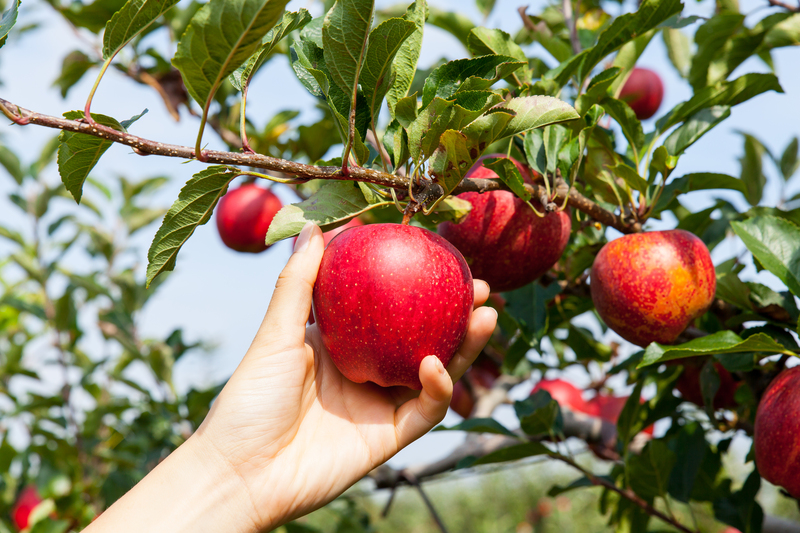Master the Art of Weed Control with These 3 Tips
Posted on 30/06/2025
Master the Art of Weed Control with These 3 Expert Tips
Are stubborn weeds turning your beautiful garden beds and lawns into a never-ending battleground? You're not alone! Gardeners and homeowners across the globe wage war every season against persistent, unsightly, and invasive weeds. Knowing how to control weeds effectively is crucial for achieving a lush, healthy lawn and thriving plants. In this comprehensive guide, we'll reveal three proven strategies that empower you to master the art of weed management. Whether you're a beginner or a seasoned green thumb, unleash your yard's full potential with these invaluable tips!

Why Is Weed Control So Important?
Weeds aren't just an eyesore--they actively compete with your desired plants and turf for water, nutrients, and sunlight. They can stifle growth, reduce crop yield, harbor diseases and pests, and disrupt the delicate balance of your ecosystem. Effective weed control is essential for:
- Boosting the overall health and appearance of your garden, flower beds, and lawn
- Reducing the use of chemical pesticides and herbicides
- Protecting biodiversity and minimizing environmental impact
- Saving time, money, and effort on yard maintenance in the long run
Tip 1: Practice Preventative Weed Management for Long-Term Success
One of the best weed control strategies is prevention. By stopping weeds before they have a chance to take root and spread, you'll save countless hours of back-breaking work later on. Prevention is the foundation of sustainable weed management, whether you care for a vegetable patch, flower garden, or your front lawn. Here are key steps to hinder weed growth from the very beginning:
1. Build Healthy Soil
Strong soil rich in organic matter supports robust root growth for your preferred plants, making it tougher for weeds to gain a foothold. To create the ideal environment for your landscape:
- Add compost, leaf mulch, or well-rotted manure regularly
- Test your soil to balance pH and nutrients
- Aerate compacted ground to enhance drainage and oxygen flow
2. Choose Ground Covers and Dense Plantings
Nature abhors a vacuum--bare soil is an open invitation for weed seeds to germinate. Fill gaps in your garden with ground covers like creeping thyme, clover, or low-growing perennials. For vegetable beds, try succession planting or interplanting species closely to shade the earth. A crowded garden leaves little room for unwanted visitors.
3. Install Borders and Edging
Lawn grass and ornamental beds often clash at the edges, where weeds are quick to invade. Use landscape edging, brick, or a sharp spade to define clear borders between turf and beds, making it easier to spot and remove errant growth.
Tip 2: Master Physical and Organic Weed Removal Techniques
If weeds have already appeared, it's vital to remove them promptly before they produce seeds and multiply. Physical weed control methods are eco-friendly, effective, and safe for your family, pets, and the environment. Here's how to tackle weed infestations with your own two hands (and a few helpful tools):
1. Hand-Pulling
For small gardens or weed patches, this traditional method can be surprisingly satisfying. Remember:
- Pull weeds when soil is moist--they release easier and you get more of the root.
- Grip low on the stem, close to the earth, and remove the entire root system.
- Wear gloves to protect your hands from thorns or irritants.
- Avoid composting weed seed heads or rhizomes, which might survive and spread later.
2. Hoeing and Cultivating
For larger patches or paths, a sharp hoe is your best friend. Slice weeds just below the soil line--this severs their nutrient supply and exposes roots to dry out. Cultivators and stirrup hoes are also excellent for quickly uprooting shallow weeds in vegetable beds.
3. Mulching for Weed Suppression
Mulching is a top organic defense against weed invasion. A thick 2-4 inch layer of mulch (straw, bark chips, pine needles, shredded leaves, or compost) blocks sunlight, preventing weed seeds from sprouting. Mulch also retains soil moisture and adds nutrients as it breaks down. For added weed barrier power, apply a layer of biodegradable cardboard or newspaper beneath mulch.
4. Smothering with Landscape Fabric
For persistent or aggressive weeds, such as bindweed or Bermuda grass, try smothering them under landscape fabric or black plastic. This deprives the plants of sunlight and oxygen, eventually killing them at the root. It's ideal for future beds, paths, or problem areas you want to reclaim.
Tip 3: Choose the Right Chemical Weed Solutions (But Use with Caution!)
Sometimes, despite your best efforts, a severe weed infestation may require targeted chemical control. The key is responsible, selective herbicide use--always follow label instructions, choose products appropriate for your weed species, and opt for the least toxic alternatives whenever possible.
1. Pre-Emergent Herbicides: Stop Weeds Before They Start
Pre-emergent weed killers work by forming a barrier on the soil's surface that prevents seeds from germinating. They're ideal for crabgrass, chickweed, and other annual weeds common in lawns and beds. Apply pre-emergents in early spring or fall, before weeds appear. Note they won't affect existing, established plants, or perennial weeds with deep roots.
2. Post-Emergent Herbicides: Target Visible Invaders
Post-emergents attack weeds that have already emerged through the soil. Types include:
- Selective herbicides: Kill weeds but spare your turf or crops (ideal for dandelions or clover in grass lawns).
- Non-selective herbicides: Kill any plant they touch (best for walkways, driveways, or total bed renovation).
3. Organic and Homemade Weed Control Alternatives
If you want to avoid chemicals altogether, try natural solutions:
- Boiling water or horticultural vinegar for cracks in sidewalks
- Corn gluten meal to suppress seeds in veggie beds
- Flame weeders (with caution!) for driveways and paths
Bonus Tips for Weed Control Mastery
- Keep your mower blade sharp and mow high--taller grass shades out weed seedlings.
- Inspect new plants, mulch, or soil for weed seeds before adding them to your garden.
- Rotate annual crops to disrupt weed life cycles in vegetable gardens.
- Keep up regular weeding sessions--a few minutes a week beats hours of struggle later!
- Encourage natural weed predators like ground beetles or mulching with straw to attract them.

The Bottom Line: Become a True Weed Control Pro
With these expert weed control techniques and a little persistence, you can enjoy a beautiful, weed-free lawn and thriving garden borders all season long. Remember--prevent, remove, and, when necessary, selectively treat. If you make weed management a regular part of your gardening routine, catching invaders early and minimizing their spread, you'll have more time to enjoy the fruits of your labor--and less time fighting nature's persistent green rebels!
Frequently Asked Questions about Weed Control
- How can I stop weeds from coming back every year?
Consistent mulching, dense plantings, and prompt weed removal are key. Don't let weeds go to seed and always monitor for new growth. - What's the safest weed killer for pets and kids?
Try manual removal, corn gluten meal, or organic mulches. If chemicals are needed, research pet-safe options and keep animals off treated areas until it's safe. - Can I really control weeds without using chemicals?
Absolutely! Many gardeners master organic weed management with methods like hoeing, mulching, and hand-pulling. It requires diligence but is entirely possible.
Ready for a Weed-Free Landscape?
Don't let weeds steal the spotlight in your garden. Take control with these three proven weed control techniques. By blending prevention, organic removal, and careful treatment, you'll master weed management and boost your landscape's beauty and health.
For tailored advice or to learn more about advanced weed eradication solutions, consult your local cooperative extension or gardening expert. Here's to a greener, healthier, and weed-free future for your outdoor oasis!

